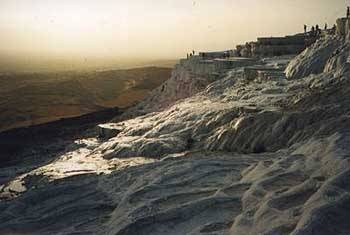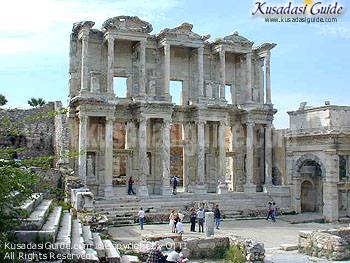|
Fethiye:
Another holiday resort of the Aegean is Fethiye which
covers the ancient city Telmessus. It was first mentioned
in the Delian League in the 5th century BC. It was the 4th
century BC when it became Lycian and years after it was
conquered by Alexander the Great just like a trick of the
Trojan Horse which was an orchestra this time, consisting
of women who successfully passed the guards and captured
the acropolis. Later on the city became a part of the
Romans and then the Byzantines when it started to be known
as Anastasiopolis. The Medieval
Castle remains that encircles Fethiye, Lycian
rock tombs especially the one that belongs to
Amyntas are worth seeing in the ancient city. Close to
Fethiye, there is Dead Sea ( Olu Deniz) which is one of
the wonders of the nature. The dead is a reference to the
calmness of the sea. It is 325km
from Kusadasi.
Denizli:
One of the cities of the Aegean is Denizli where all kinds
of grain, sugar beet, cotton, tobacco and grapes grow. It
is 200km away from
Kusadasi. Denizli is surrounded by many ancient cities. Goncali
(Laodicea Ad Lycum) for example, which used to be an
important city in Anatolia, built on a natural trade
route. It was, in the Roman period, the metropolis of
Asia, a center of banking and exchange, cloth weaving with
goat's wool which has the color of dark black that was
resulted because of the water with minerals the goats and
the sheep drank. The city was named after the wife of its
founder Seleucid Dynasty in the 3rd century BC. For awhile
the Kingdom of Pergamum took the control of the city.
During the early Christianity an important council was
held in here in the 4th century AD. The Stadium,
Water Tower, Gymnasium,
Baths Complex, Odeon,
Nymphaeum, Hellenistic
Theatre and Roman
Theatre are worth seeing ruins of the city.
Besides the city is famous for being one of the Seven
Churches of Revelation.

Pamukkale
Pamukkale:
Pamukkale,
with its ancient name Hierapolis,
is famous and popular for its hot springs which are
believed to heal the patients. The city had a mixed
population as it was at the borders of Caria, Lycia and
Phrygia. The terraces of Pamukkale were formed by the
running hot water that has the temperature of 35°C which
contains calcium bicarbonate. The water loses its carbon
dioxide it leaves limestone deposits. According to the
scientists, the terraces began forming 14000 years ago. A
few kilometers away from Pamukkale close the village
Karahitay thereis another thermal spring called Kirmizi Su
(red water) which has warmer water but less carbon dioxide
which causes the running water create a red ground
different than the white terraces. In the borders of
Pamukkale there is the ancient city Hierapolis which was
founded by the king Eumenes II of Pergamum in the 2nd
century BC. This ancient city is one of the ancient cities
in the world that applied grid-plan. The largest ancient
cemetery is also here which is called the Necropolis.
Apart from that, in the ancient city Hierapolis, the Martyrium
Apostle Philip's tomb where he was stoned to
death, the Roman Bath which was converted into a Basilica
in the 5th century, the Triple
Arch which is the northern gateway of the city,
the Colonnaded Street,
the Sacred Pool, the Plutonium
which was a shrine of Pluto, the god of the dead and
underground and the Theatre
which had the capacity of 20000 seats are worth seeing
ruins in the ancient city Hierapolis.

Ephesus
Ephesus:
Another ancient city in the region is the most popular and
famous one, Ephesus which was the home of the philosopher
Heraclitus. He introduced into philosophy a new
self-consciousness method and language and a self-critical
interest in the faculties. Ephesus was also one of the
Seven Churches of Revelation In the ancient city
there are many ruins which are worth seeing and it is a
must for someone who is either interested or not to see
this city.
*The Temple of Artemis,
an Archaic Processional Road around the Panayir
Dagi (Mount Pion),
*Stoa of
Damianus, Basilica of St. John, the Citadel,
*Isa Bey Mosque, the House of Virgin Mary
which was declared officially to be the shrine of the
Roman Catholic Church in 1896 and since then it has been
one of the popular pilgrimage place,
*The Bath of Varius,
the State Agora, the Temple
of Peripteros, the Nymphaeum of Laecanius Bassus,
*The Odeon which was used as a theatre and as Bouleterion,
the Temples of Dea Roma and Divus
Julius,
*The Prytaneion, Memmius
Monument, the Polio Fountain
from where the water brought by aqueducts and distributed
by a branching system of baked clay pipes,
*The Domitian
Temple, the Hercules
Gate, the Curetes
Street (in literary
sources Embolos) between the Hercules Gate and the Celsius
Library,
*The Nymphaeum of Trajan which
was built in the memory of the king Trajan, the Terrace
Houses which were on the Curetes Street and
belonged to the rich of Ephesus,
*The Scholastic Baths
between the two sides of Bath Lane and Academy Street, the
Hadrian Temple which
was dedicated to the king Hadrian,
*The Latrines
which were the parts of the Scholastic Baths, the Private
House (Brothel) which was also a part of the
Scholastic Baths,
*Library Square
which was a burial street with buildings Octagon
which was a vaulted burial chamber,
*Heroon which
was a U-shaped building, Celsius Library and Sarcophagus, Hadrian's
Gate which had three stories,
*The Celsius Library
which was built by Gaius Julius Aquila as a
memorial for his father Gaius Julius celsus Polemaeanus
who was buried inside the library under the middle apse,
*The Commercial Agora which
was surrounded by stoas with two aisles behind which used
to be shops, Mazaeus-Mithridates Gate which opened
to the commercial agora next to the library,
*The Marble
Road between the
library and the theatre, the Theatre
which had the capacity to hold 24000 people, the Arcadiane
which was a colonnade avenue leading from the harbor to
the theatre,
*The Ephesus Museum which is in Selcuk
exhibits the marble statues of Artemis, rows of egg-shaped
marble pieces on the goddess's chest are among the ruins
there are worth seeing in the ancient city Ephesus.
<<<BACK
NEXT>>>
|
